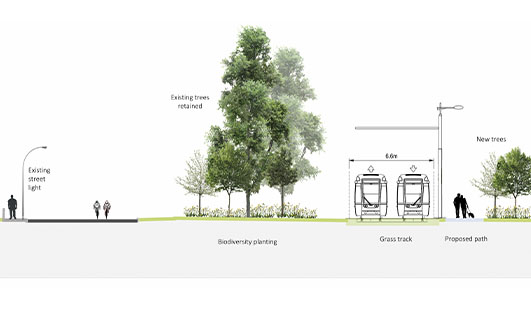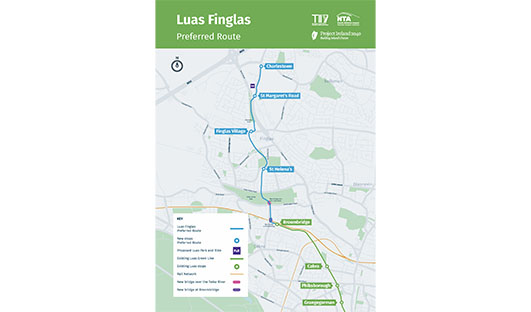Luas Finglas: Fast, reliable and sustainable transport

Luas Finglas is the next extension of the Luas Green Line from its current terminus at Broombridge to a new terminus in Charlestown. It will create a new public transport connection between the communities of Charlestown, Finglas Village, Finglas West, St Helena’s, Tolka Valley and the city centre, writes Marcello Corsi, Project Manager of Luas Finglas.

The proposed route is 3.9km in length and will include four new stops: St Helena’s, Finglas Village, St Margaret’s, and Charlestown. A 350-vehicle park and ride (P&R) facility will be provided near the St Margaret’s Road stop, close to the M50. The route will provide interchange opportunities with bus networks at all the new stops and with mainline rail services at Broombridge. Most of the route will be built using grass track, an attractive and sustainable innovation for urban transport in Ireland.
The primary basis for the project is set out in the transport strategies for the Greater Dublin Area 2016-2035 and 2022-2042, which outline the proposed transport solutions to support economic and spatial development in Dublin. Luas Finglas will provide people living and working in northwest Dublin with a fast, reliable, accessible and sustainable transport service, while enabling compact growth. The strategic case is also underpinned by Project Ireland 2040, including its National Development Plan 2021-2030 and the Climate Action Plan 2021.
As part of an integrated transport system, Luas Finglas will provide alternative transport options to residents and encourage a move from private cars to public transport. This will reduce greenhouse gas emissions and help enable a transition to both a low carbon and increasingly climate resilient society in line with the ambitions set out in the Climate Action Plan 2021.
Luas Finglas will involve the construction of two major structures, a bridge over the Railway and the Royal Canal at Broombridge, and a bridge over the Tolka River in Tolka Valley Park. Both structures are being designed to stand out in terms of visual, aesthetic and environmental quality.
The scheme will incorporate active travel modes along the alignment, including attractive walking and cycling infrastructure.
Luas Finglas will be comparable to the higher speed sections of the Luas network as it will be built along a brand new, fully segregated, mostly off-road corridor. According to initial estimations, journey times from Charlestown (M50) to Trinity College in the city centre will be approximately 30 minutes, and this runtime will be consistent due to the high level of segregation.
Luas Finglas passengers commuting to and from the city centre will benefit from the existing high capacity, high speed section of the Luas Green Line between Broombridge and Parnell Street as this largely off-road rail-based public transport corridor from the M50 to the north city centre will deliver a consistent and competitive runtime while freeing road capacity in the critical areas of Finglas, Phibsborough, and the north inner city.
The benefits of Luas Finglas will go well beyond the users’ benefits, as the scheme will enable and act as a catalyst for a wider regeneration of the Finglas and Charlestown areas in the north-west suburbs of Dublin.
Progress to date
The project commenced in 2018 with Phases 0 and 1. The options selection process was completed in the summer of 2020 with the publication of the emerging preferred route (EPR) and the first non-statutory public consultation (NSPC).
In 2021, TII appointed an engineering designer (Barry Transportation/Egis joint venture) to support the development phases, and the EPR was developed to the preferred route (PR) taking into account feedback received during the first NSPC. A second NSPC on the PR was held in Q4 2021 with feedback being largely positive. Changes from the EPR to the PR included the relocation of three of the four stops and the P&R, the realignment of the corridor in five areas, and fully aligning the active mode elements of the scheme with the Draft Greater Dublin Area Cycling Strategy, published by the NTA in 2021. Luas Finglas preferred route preliminary design was completed in Q1 2022.
Next steps
The next steps will include the development of the reference design, preliminary business case, environmental impact assessment report (EIAR) and all planning documentation with a view to submitting a planning application in Q3 2023, subject to prior Government approval and funding availability.
Social benefits of Luas Finglas
The scheme will act as a strong catalyst for social opportunities through improved access to jobs, education, leisure and social facilities throughout Finglas and Charlestown. Furthermore, areas adjacent to the preferred route (e.g., north Broombridge, west of Finglas Village and Charlestown environs) will become increasingly attractive for residential, employment and/or mixed-use development, supporting the ambition for compact, ‘transit-oriented’ development as set out in Project Ireland 2040. The recent rezoning of industrial lands in Jamestown by Dublin City Council is a testament to this process.

Circular economy on Luas Finglas
TII is committed to delivering on a Circular Economy (CE) Plan along with a pilot study to apply the principles of CE to the Luas Finglas project.
The project design teams are undertaking CE workshops to explore and prioritise opportunities for integrating CE principles in the project approach. Key opportunities identified are as follows:
1. Earthworks optimisation: adopting a hierarchy for soil reuse on the project;
2. Design for disassembly of track: adopting a design for disassembly approach to track design improving maintenance and track replacement over the life cycle;
3. Material data integration in the project BIM1 strategy: integration of key material data into the project data environment;
4. Sharing of lighting and other assets: Public lighting, CCTV, and signage to be designed to avoid duplication of components such as lighting poles; and
5. Adopting nature-based solutions and a regenerative design approach: project to be designed to achieve optimal outcomes for biodiversity, drainage, planting, and design of public space.
Sustainability on Luas Finglas
Sustainability objectives and strategies for Luas Finglas align with those set out in the National Planning Framework, part of Project Ireland 2040, and the Sustainable Development Goals National Implementation Plan 2018-2020.
The sustainability approach to Luas Finglas is also guided by TII’s Statement of Strategy 2021 to 2025 and the TII Sustainability Implementation Plan – Our Future (2021). There is a dedicated sustainability plan for addressing the key sustainability challenges, risks and opportunities of the Luas Finglas scheme and its long-term planning and operation.
The sustainability plan focuses on the following key points:
• Reduce environmental impacts: protect, preserve, and improve biodiversity, promote urban ecology and ecosystem services;
• Low carbon transport: provision of a low-emission light-rail, carbon assessment and offset of carbon footprint;
• Resource efficiency: minimise waste, sustainably use materials and natural resources;
• Infrastructure resilience: provision of a reliable and climate resilient light-rail service;
• Accessibility and sustainable growth: provide integrated transport solution with better linkages between people, places and resources to drive economic activity and enhance regional productivity;
• Health and well-being: address air quality issues in urban and rural areas through better planning and design; and
• Engagement and collaboration: enhance collaborations, stakeholder, and public engagement.
Urban and landscape integration
Luas Finglas runs through several parks and local open spaces. It is therefore important that the existing use of these spaces, and opportunities for their enhancement are realised through the design process. Approximately 70 per cent of the line will run on grass track which will aid its visual integration in the spaces it passes through.
Integrating Luas Finglas into its receiving environment requires consideration of a number of elements such as its transport function, opportunities for water management at waterway crossings, local landscape and biodiversity, and critically the local communities.
Luas Finglas stops are located and designed to optimise access, social activity, personal safety and interchangeability; to make a positive contribution to the built environment by using simple high-quality materials, minimisation of clutter and respect for the character and context of their surroundings.
Reference to local authority policies, development plans and guidelines formed an initial basis for decision making.
As the project developed, there was close consultation with all municipal divisions regarding planning for existing and future land use, integration with parks and landscape, and consideration of lighting, architectural heritage, roads etc.
Careful consideration was given to St. Margaret’s Road itself, its future use, and its configuration. Here, the light rail alignment is envisaged as a linear green edge to the future Jamestown Development, with grass track and a strong tree line separating light rail from the road carriageway. Landscaping is being utilised to break up the remaining expanse of road by segregating modes in a safe and attractive way.
Universal Design is at the heart of the Finglas extension with consideration being given to people with disabilities, people with mobility issues, or women travelling alone. This is manifested in fully accessible and uncluttered layouts, which are safe and easy to navigate and involve prioritisation of walkers, cyclists and vulnerable users.
Active mobility on Luas Finglas
For much of its length, Luas Finglas will form a new transport corridor that will serve an array of local key trip attractors including schools, sporting facilities, parks and services. The Luas Finglas transport corridor will therefore likely generate short distance trips to and from these facilities. The project team leveraged any opportunity to facilitate active travel and improve walking and cycling facilities. As such, an exciting aspect of Luas Finglas is the opportunity to incorporate safe, segregated cycling and pedestrian paths along several sections of the route. This will provide integration between the scheme and the surrounding areas and enable short-distance trips to and from various destinations in the vicinity of the line. Active travel elements will also provide an important link between the wider Finglas area and the Tolka Valley and Royal Canal greenways, while integrating with and complimenting the Draft Cycle Network Plan 2021 for the Greater Dublin Area.
Use of BIM and 3D models
One of TII’s key strategic objectives involves BIM models and other information generated as part of project development being utilised to support efficient development of the design in close collaboration with all project stakeholders. A Common Data Environment (CDE) has been established for the project. This will be opened to contractors at construction stage to ensure the correct management of Engineering content throughout the project.
Upon completion of the reference design, a higher degree of certainty in achieving stakeholder buy-in can be accomplished with design information generated from geometrically verified Engineering models supplemented with concept 3D visualisations, compared to just drawings.
Having ‘virtually built’ and interrogated the design and engaged with project stakeholders throughout earlier design development phases, this will aid in stakeholders’ understanding of the project scope and allow for improved interaction and input.
Mitigating conflicts through model and information coordination is a key project requirement. Processes have been developed to minimise conflicts, promote sharing of project information, more efficient design development, and gap analysis and interface management. Luas Finglas is being built twice, virtually by the design team and in real life during construction.
E: Marcello.Corsi@tii.ie
W: www.tii.ie






